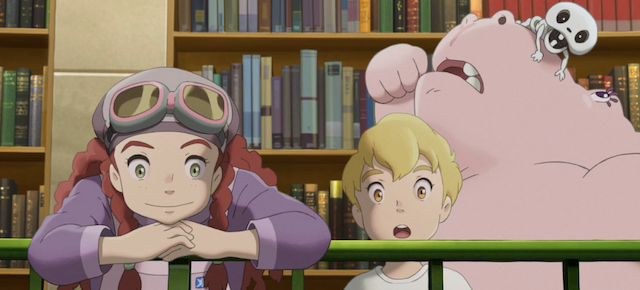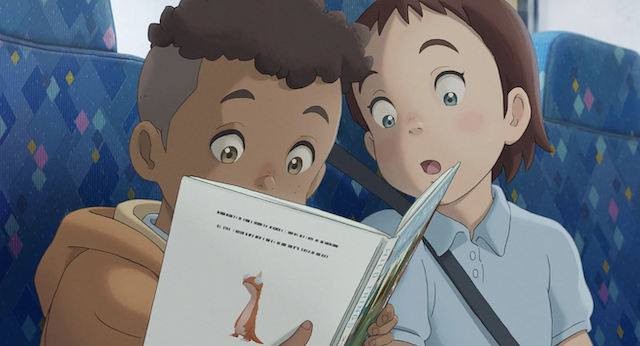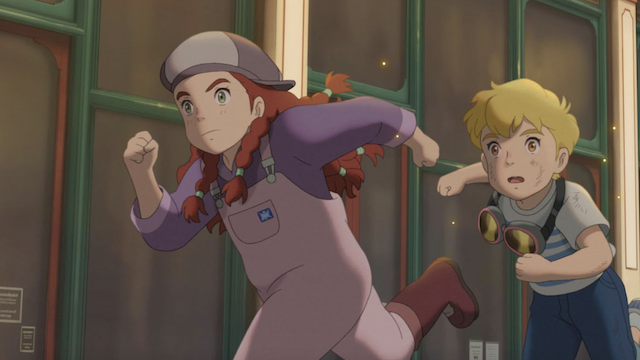
The Imaginary, @Courtesy of Netflix and Studio Ponoc
The Imaginary : Rudger is a boy no one can see, imagined by Amanda to share her thrilling make-believe adventures. But when Rudger, suddenly alone, arrives at The Town of Imaginaries, where forgotten Imaginaries live and find work, he faces a mysterious threat.
Director : Yoshiyuki Momose
Producer : Yoshiyuki Momose
Screenwriter : Yoshiaki Nishimura
Distributor : Netflix
Production Co : Studio Ponoc
Rating : PG (Thematic Elements|Peril|Some Violence|Scary Images)
Genre : Fantasy, Adventure, Anime
Original Language : Japanese
Release Date (Theaters): Jun 28, 2024, Limited
Release Date (Streaming) :Jul 5, 2024
Runtime : 1h 48m

Q : You started studying live-action filmmaking in the United States…
Yoshiaki Nishimura: Yes, I wanted to make films so I came to Los Angeles where I started at Los Angeles City College and then went to UCLA Extension Program.
Q : What then took you away from live-action and drew you to animation?
Yoshiaki Nishimura: I came to the United States because when I was young I watched so many American movies and I loved them. I was enthusiastic about that form of entertainment. One day when I was living here I saw this little girl watching TV and actually speaking to the characters of this show.
She was actually watching an animated film and she was screaming at one character: “Please don’t be so mean to the other guy!” I understood that I wanted to do something for the children since I was fourteen. So the idea of bringing together moviemaking and children could only mean animation. That’s why I decided to create animated movies.
Q : In 2002 you joined Studio Ghibli, working together with Hayao Miyazaki on movies like Ponyo and Howl’s Moving Castle. What kind of experience has it been working with this legend?
Yoshiaki Nishimura: I was actually the first person hired by Studio Ghibli straight out of college. The Co-founder Toshio Suzuki introduced me to Hayao Miyazaki saying I was the new guy, and I was American. I had to correct him. I started learning how to create animation just by watching Miyazaki every day. I fell in love with the magnificent experience of watching him at work. He’s not someone who teaches you with words, just like the other creators I just kept watching the way he used to work. He can teach you a lot with just the way he behaves.

The Imaginary, @Courtesy of Netflix and Studio Ponoc
Q : And then you were assigned to make a movie with another Studio Ghibli genius, Isao Takahata. So you spent about eight years working with him, planning and producing his last movie The Tale of Princess Kaguya, which was nominated for an Academy Award in 2013. Do you consider Takahata your mentor?
Yoshiaki Nishimura: When I was told that I had to produce Mr. Takahata’s film, I went to visit him. The first time he told me: “I don’t want to make films. But since you want, I am going to get along with you!” Since that day I started spending a lot of time with him, about twelve hours a day for basically four years. I spent all the time eating breakfast, lunch, and dinner cooked by his wife. I think she saw me like a son.
I learned something fabulous because Mr. Takahata truly knows that a movie is a combination of many parts and many influences. He started talking to me about many other forms of art like literature, architecture, music, and so on. One day he brought ten CDs with forty-one Mozart symphonies, and then he started listening and comparing them. This way he taught me how to see and approach different arts.
Q : Did his teachings influence you in making The Imaginary?
Yoshiaki Nishimura: Of course. Because of his education, I became aware of different perspectives. The animation of Disney was for example more preeminent in the world than Japanese animation and influenced me, but also other Countries like Czech animation. All these influences I was exposed to, made me fully understand how 2d animation has endless possibilities and expression, it just depends on how you incorporate them. What I learned most from Mr. Takahata was to challenge myself with new things to try.
Q : In 2015 you founded Studio Ponoc. How did you decide to go on your own?
Yoshiaki Nishimura: This may be not of public dominion in the United States but Studio Ghibli in 2014 shut down the production division. So about two hundred and thirty creators have been laid off. At that time I understood that Mr. Miyazaki and Mr. Takahata didn’t have the energy to create further animation, I felt that the great work they produced had to be carried on by someone. So I decided to dive in and try out.

The Imaginary, @Courtesy of Netflix and Studio Ponoc
Q : Why did you decide to adapt A.F. Harrold’s 2014 book? Why not a Japanese book?
Yoshiaki Nishimura: I’ve read children’s literature from all over the world, not only Japanese. United States, France, and Germany. Stories for children don’t have borders, I just picked the novel that I love, the fact that it is English can be a simple coincidence. I was attracted by the amusement that I felt reading the story.
Q : What was the biggest challenge you encountered while making The Imaginary?
Yoshiaki Nishimura: There were many. Creating a world that is seen from an imaginary friend’s perspective, like the main character Ridger, forced us to create an entirely new way of looking at the world. He has his own life but at the same time is the reflection of Amanda’s inner world. I had to create background stories and worlds that were ten times longer than the actual script. And that before even going into production. All the imaginary friends were created by human beings who imagined them. These human beings may not be part of the film, but we had to dive into their worlds to fully understand their friends and their creations.
Q : How long did it take to make The Imaginary?
Yoshiaki Nishimura: It took me two years to complete the screenplay, and then another four years for concept development, character development, and creating the storyboards. Once we went into production it took between twenty-six and twenty-eight months.
Q : What hand-drawn animation has that CGI doesn’t have?
Yoshiaki Nishimura: I hope not to be misunderstood, I love CGI. I just keep seeing the infinite possibilities we have with hand-drawn animation. With animation and stop-motion, the characters exist in a sort of tangible world, their reality is just there. The creator can see, change, and make his character better on a daily basis, the drawing is just there for him to work with. The poetry of a drawing is actually the fact that it is not perfect, and just because of that it has the power to evoke something in the audience. This way the piece of work is completed by the audience, it’s a process that we need to do together. It is still such an attractive medium to explore to me.

The Imaginary, @Courtesy of Netflix and Studio Ponoc
Q : Why did you decide to collaborate with a French animation studio for The Imaginary?
Yoshiaki Nishimura : Japanese animation hasn’t really changed in the last thirty, or forty years. I feel the backgrounds and the settings became more refined but the characters became more and more simplified. I felt that if we were able to add some texture, and some lightning to our characters, maybe we would have been able to move some steps forward. being able for example to control the shadows means controlling the emotions that a character can deliver to the audience.
Q : Are you thinking about producing movies not only for children but also for a bigger audience?
Yoshiaki Nishimura: Sometimes investors try to push you in that direction, to make more money. Because children don’t have money. But I have a conviction that I share with Mr. Miyazaki and Mr. Takahata, that something that was created for children, shouldn’t switch to the judgment of adults. Like Rudger, we want to stand by children and focus on their existence.
Q : What does the word Ponoc mean?
Yoshiaki Nishimura: It is a Croatian word that means midnight. It means something special to us because so many people working with us were employed at Studio Ghibli. They brought their experience, their art, their poetry. Something that we cherish, that is so important to us. At the same time, we want to pursue, to explore new ways to create animation. So midnight is a point when the old day and the new day connect. It is a link between the past and the future that we want to write about with the challenges we want to face.

The Imaginary, @Courtesy of Netflix and Studio Ponoc
If you like this article, share your thoughts below!
Check out more of Adriano’s articles.
Here’s the trailer of The Imaginary:


I was just looking for this information for some time. After six hours of continuous Googleing, at last I got it in your site. I wonder what is the lack of Google strategy that don’t rank this type of informative websites in top of the list. Generally the top web sites are full of garbage.